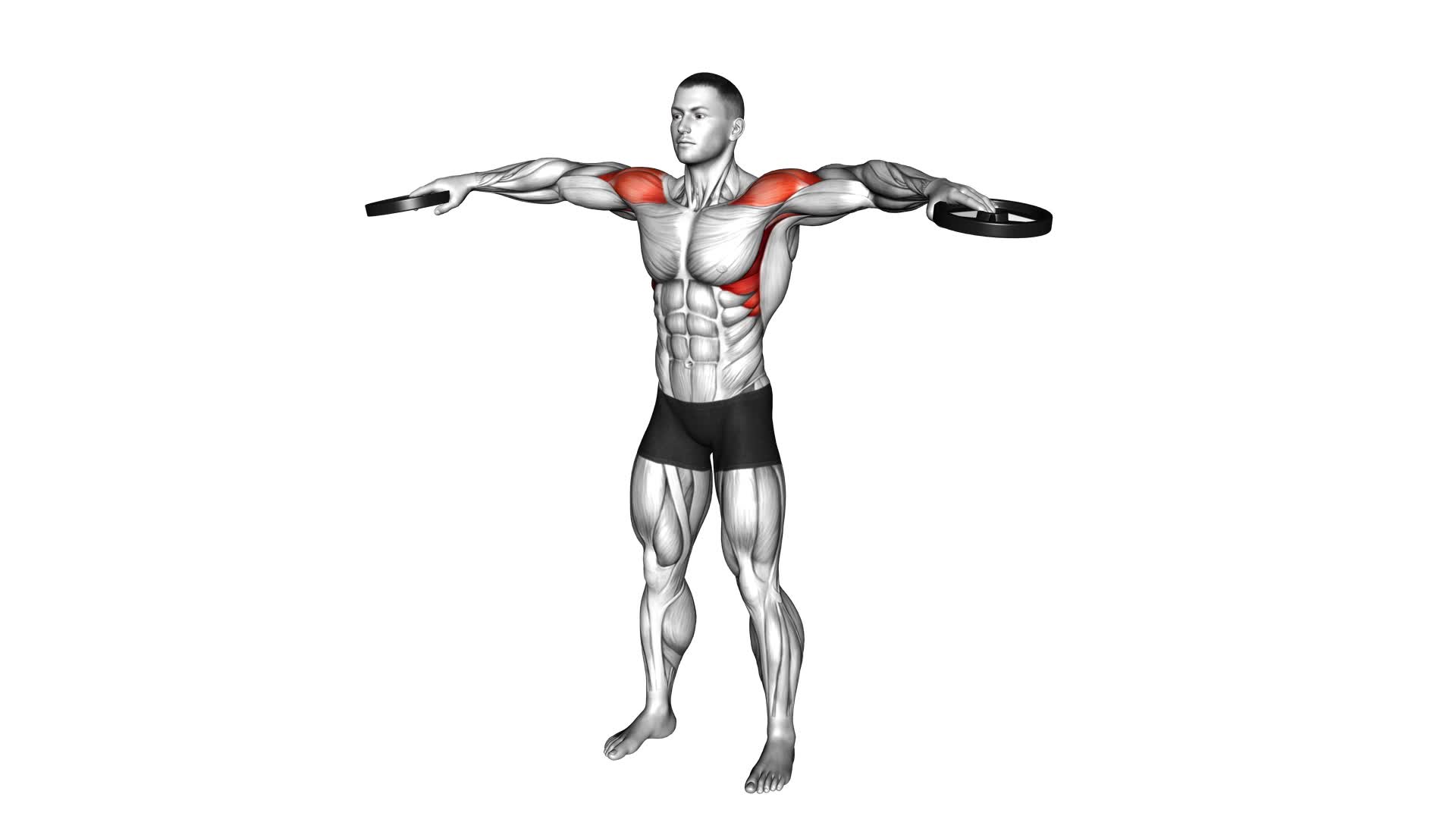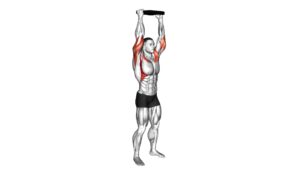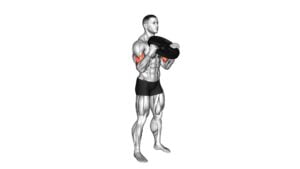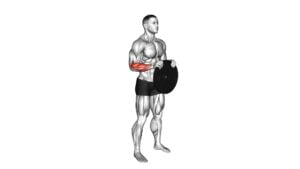Weighted Plate Standing Lateral Raise (male) – Video Exercise Guide & Tips

Are you looking to tone and strengthen your shoulders and upper body? Look no further than the Weighted Plate Standing Lateral Raise.
Watch This Exercise Video
This exercise is a great way to target those muscles and add definition to your physique. In this article, you'll find a video exercise guide and helpful tips to ensure proper form and technique.
Plus, we'll provide suggestions on how to choose the right weight and challenge yourself with variations.
Get ready to elevate your workout routine!
Key Takeaways
- Targets the medial deltoid for wider and more defined shoulders
- Engages the anterior and posterior deltoids and trapezius muscles
- Improves overall shoulder stability and mobility
- Helps correct muscle imbalances and improve posture
Benefits of the Weighted Plate Standing Lateral Raise
To maximize your shoulder strength and definition, incorporate the weighted plate standing lateral raise into your workout routine. This exercise offers several benefits for shoulder development.
Firstly, it targets the medial deltoid, which is responsible for lateral shoulder movement. By strengthening this muscle, you can achieve wider and more defined shoulders. Additionally, the weighted plate standing lateral raise also engages the anterior and posterior deltoids, as well as the trapezius muscle. This comprehensive shoulder workout helps to improve overall shoulder stability and mobility.
Another benefit of this exercise is that it can help correct muscle imbalances. Many people tend to have stronger front delts compared to their rear delts, leading to rounded shoulders. The weighted plate standing lateral raise specifically targets the rear delts, helping to balance out your shoulder muscles and improve posture.
Moreover, the weighted plate standing lateral raise is a compound movement that engages multiple muscles simultaneously. This means that it not only strengthens your shoulders but also works your core and upper back muscles. By incorporating this exercise into your routine, you can achieve a more balanced and well-rounded physique.
Proper Form and Technique for the Exercise
To perform the weighted plate standing lateral raise exercise with proper form and technique, follow these steps:
- Grasp a weighted plate with both hands and stand with your feet shoulder-width apart.
- Maintain a slight bend in your knees and engage your core for stability throughout the movement.
- Begin by holding the weighted plate in front of your thighs, with your palms facing your body.
- Inhale and slowly raise the plate out to the sides, keeping your arms straight and parallel to the floor.
- Avoid swinging or using momentum to lift the weight.
- One common mistake to avoid is shrugging your shoulders as you lift the plate. Instead, focus on maintaining a relaxed and neutral shoulder position.
- Another common mistake is lifting the weight too high, which can strain your joints and decrease the effectiveness of the exercise. Aim to raise the plate to shoulder level or slightly below, while maintaining control and tension in your muscles.
- Remember to exhale as you lower the weight back down to the starting position.
- Throughout the exercise, maintain proper posture by keeping your chest up and your back straight.
How to Choose the Right Weight for Optimal Results
To determine the appropriate weight for optimal results, you should start with a moderate weight that allows you to complete the exercise with proper form and technique. This means choosing a weight that challenges you without sacrificing your ability to perform the exercise correctly. As you become more comfortable and proficient with the exercise, you can gradually increase the weight to continue challenging your muscles and promoting progress.
When it comes to progressing in weight selection, it's important to listen to your body. Pay attention to how your muscles feel during and after each set. If the weight feels too light and you're not experiencing any fatigue or muscle burn, it may be time to increase the weight. On the other hand, if the weight feels too heavy and you're struggling to complete the exercise with proper form, it's a sign that you should decrease the weight.
Common mistakes in weight selection include starting with weights that are too heavy or increasing the weight too quickly. This can lead to improper form, increased risk of injury, and hindered progress. Remember, it's better to start with a lighter weight and gradually work your way up as your strength and technique improve.
Variations and Modifications to Challenge Yourself
Challenge yourself with different variations and modifications to enhance the effectiveness of the Weighted Plate Standing Lateral Raise exercise. By incorporating progression options and advanced techniques, you can take your workout to the next level and continue to see improvements in strength and muscle development.
One way to challenge yourself is by increasing the weight of the plate. Gradually increase the load to provide a greater resistance for your muscles to work against. This will help to stimulate muscle growth and increase strength over time. Remember to maintain proper form and technique while using heavier weights to prevent injury.
Another variation to consider is performing the exercise on an unstable surface, such as a BOSU ball or a balance board. This will engage more stabilizer muscles, making the exercise more challenging and effective. Start with a lighter weight when attempting this variation, as it requires more control and balance.
To add an extra challenge, try performing the exercise in a slow and controlled manner. Slow down the tempo of the movement, focusing on the eccentric and concentric phases. This will increase time under tension, promoting muscle growth and strength gains.
Incorporating these progression options and advanced techniques into your Weighted Plate Standing Lateral Raise routine will help you continue to challenge your muscles and reach new levels of strength and fitness. Remember to listen to your body and adjust the intensity as needed to ensure a safe and effective workout.
Tips for Incorporating the Exercise Into Your Workout Routine
When incorporating the Weighted Plate Standing Lateral Raise exercise into your workout routine, focus on maintaining proper form and technique to maximize the effectiveness of the movement.
Here are some tips to help you incorporate this exercise into your routine:
- Start with a weight that challenges you but still allows you to perform the exercise with proper form. Gradually increase the weight as you become stronger.
- To modify the workout, you can try using resistance bands instead of weighted plates. This can provide a different level of resistance and target your muscles in a slightly different way.
- Incorporate the Weighted Plate Standing Lateral Raise exercise into your upper body or shoulder-focused workouts to ensure you're targeting the right muscle groups.
- If you're looking to progress the exercise, you can try performing it on an unstable surface, such as a Bosu ball or a balance board. This will engage more stabilizer muscles and increase the difficulty of the exercise.
- Remember to listen to your body and take breaks when needed. It's important to gradually increase the intensity and difficulty of the exercise to avoid injury and promote proper muscle development.
Frequently Asked Questions
Can the Weighted Plate Standing Lateral Raise Help to Build Muscle Mass in the Shoulders?
Yes, incorporating the weighted plate standing lateral raise into your shoulder workouts can help build muscle mass in your shoulders.
This exercise specifically targets the lateral deltoids, which are responsible for the width and overall shape of your shoulders.
By using a weighted plate, you can increase the resistance and challenge your muscles, leading to muscle growth.
Additionally, there are variations of lateral raises that can target different areas of the shoulders for a more comprehensive workout.
Is the Weighted Plate Standing Lateral Raise Suitable for Beginners?
Proper form is crucial for the weighted plate standing lateral raise. It's important to ensure that you maintain a straight back and engage your core.
As for alternatives for beginners, you can try dumbbell lateral raises or resistance band lateral raises, which are less demanding on your shoulders. Remember to start with lighter weights and gradually increase as you build strength and confidence.
Always consult with a professional trainer for personalized guidance.
Can the Exercise Be Performed With Dumbbells Instead of a Weighted Plate?
Yes, you can perform the exercise with dumbbells instead of a weighted plate. However, using a weighted plate has its benefits.
It allows for a more natural movement pattern and engages your stabilizer muscles. Additionally, it provides a better grip and allows for easier progression in weight increments.
How Many Sets and Reps Should Be Performed for Optimal Results?
To achieve optimal results with the weighted plate standing lateral raise, it's important to consider the number of sets and reps you perform. The right combination can help you build strength and muscle definition.
Can the Weighted Plate Standing Lateral Raise Help to Improve Posture?
Incorporating weighted plate exercises into your workout routine can bring several benefits, including improved posture. One exercise that can help with this is the weighted plate standing lateral raise.
By targeting the muscles in your shoulders and upper back, this exercise can help strengthen the muscles responsible for maintaining good posture.
However, it's important to avoid common mistakes, such as using too heavy of a weight or swinging your body to lift the plate.
Conclusion
Incorporating the weighted plate standing lateral raise into your workout routine can bring a range of benefits, including improved shoulder strength and stability. By following proper form and technique, and choosing the right weight for your fitness level, you can optimize your results.
Additionally, challenging yourself with variations and modifications can help take your workout to the next level. So, why not give this exercise a try and see the positive impact it can have on your fitness journey?

Author
Years ago, the spark of my life’s passion ignited in my mind the moment I stepped into the local gym for the first time. The inaugural bead of perspiration, the initial endeavor, the very first surge of endorphins, and a sense of pride that washed over me post-workout marked the beginning of my deep-seated interest in strength sports, fitness, and sports nutrition. This very curiosity blossomed rapidly into a profound fascination, propelling me to earn a Master’s degree in Physical Education from the Academy of Physical Education in Krakow, followed by a Sports Manager diploma from the Jagiellonian University. My journey of growth led me to gain more specialized qualifications, such as being a certified personal trainer with a focus on sports dietetics, a lifeguard, and an instructor for wellness and corrective gymnastics. Theoretical knowledge paired seamlessly with practical experience, reinforcing my belief that the transformation of individuals under my guidance was also a reflection of my personal growth. This belief holds true even today. Each day, I strive to push the boundaries and explore new realms. These realms gently elevate me to greater heights. The unique combination of passion for my field and the continuous quest for growth fuels my drive to break new ground.







